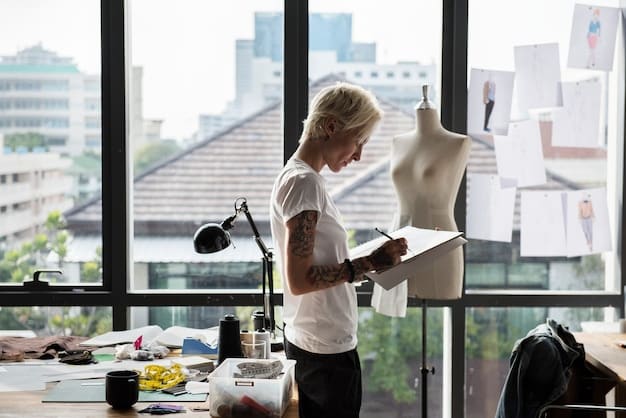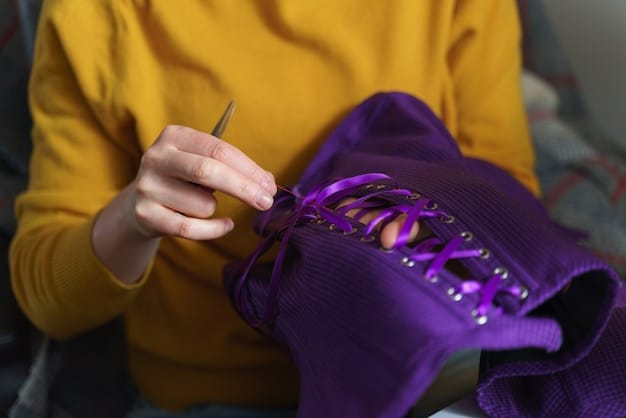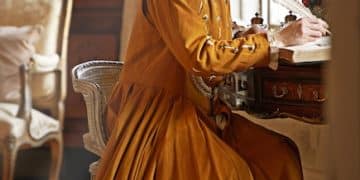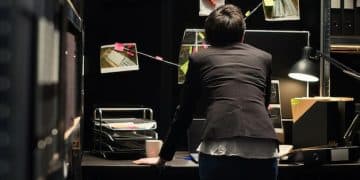The Unsung Heroes of Film: Celebrating Costume Designers

Anúncios
Costume designers are the unsung heroes of film, shaping characters and narratives through their meticulous and creative work in bringing clothing and style to the silver screen.
Anúncios
It’s easy to get lost in the on-screen spectacle of blockbuster movies, but behind every iconic look and memorable wardrobe, there’s a dedicated team of artists and craftspeople. This article focuses on the unsung heroes of film: celebrating the work of costume designers, the creative minds who bring characters to life through clothing and style.
The Power of Costume Design
Costume design is more than just selecting clothes; it’s a crucial storytelling element that can define a character, convey hidden emotions, and establish the overall tone of a film. Costume designers have the unique capacity to enrich a story with their creative decisions, enhancing the viewer’s experience with layers of meaning and interpretation.
Anúncios
From historical dramas to futuristic sci-fi, costume designers weave intricate narratives through their work. Consider how different outfits change your perception of a character, and in doing so, influence the story.
Defining Characters Through Clothing
Costumes act as visual shorthand for a character’s personality, background, and social status. Every choice, such as fabric, color, and style, is a conscious decision meant to communicate something to the audience. A character’s wardrobe can immediately tell the audience so much about who they are.
Setting the Tone and Mood
The costumes of a film play a pivotal role in establishing the movie’s atmosphere. Whether it’s the gothic gloom of a Tim Burton film or the vibrant hues of a Bollywood musical, costumes contribute significantly to the film’s overall aesthetic and emotional impact.
- Historical Accuracy: For period dramas, the accuracy of the costumes is paramount, offering viewers a glimpse into the past.
- Futuristic Visions: In science fiction, costumes often defy convention, creating imaginative and sometimes unsettling visions of the future.
- Symbolism and Metaphor: Costumes can be laced with symbolism, subtly hinting at a character’s inner journey or the story’s underlying themes.
As you watch movies, pay attention to the nuances of the costume design; you’ll find that these visual cues add depth and richness to the cinematic experience, making costume design an integral component of effective storytelling.

Iconic Costume Designers and Their Impact
Many talented costume designers have made lasting impacts on cinema, bringing memorable characters and stories to life through their creative vision. They’re the true masters of their craft. This segment highlights some of the most impactful figures in costume design and reflects on their remarkable achievements.
These designers did far more than just select clothes for a movie; they interpreted and enhanced stories through their creative decisions, and for that, their contributions will always be appreciated.
Edith Head: The Legend
Edith Head is one of the most celebrated costume designers in Hollywood history, having won eight Academy Awards for her work in films such as “All About Eve” and “Roman Holiday”. Head was known for her collaborations with iconic stars; bringing out the timeless elegance and beauty of the actors she worked with.
Colleen Atwood: The Visionary
With four Oscars to her name, Colleen Atwood has designed costumes for a wide array of films, including “Chicago”, “Alice in Wonderland”, and “Fantastic Beasts and Where to Find Them”. Her meticulous research and ability to create distinct visual styles for each project set her apart.
- Milena Canonero: Known for her work on “Barry Lyndon” and “The Shining”, Canonero is celebrated for her attention to detail and period accuracy.
- Sandy Powell: Powell has won three Academy Awards for her contributions to films like “Shakespeare in Love” and “The Young Victoria”, showcasing her versatility.
- Ruth E. Carter: Carter is renowned for her groundbreaking work in “Black Panther”, which celebrated African culture and design.
The influence of these exceptional costume designers extends beyond cinema, influencing fashion and pop culture. Costume designers leave an indelible mark, contributing to a more vibrant and visually engaging world.
The Creative Process Behind Costume Design
Creating costumes for a film is a complex process that involves research, collaboration, and a keen eye for detail. To truly understand the amount of work involved in the job, diving into the creative process is essential. It takes a costume designer, and the whole costuming team, to do what they do.
From initial concept to finished product, costume design is a blend of art and technical expertise. Appreciate the amount of work that goes into their work.
Research and Inspiration
Costume designers dive deep into research, exploring historical contexts, cultural influences, and character backgrounds. Inspiration can come from diverse sources, ranging from art history to street fashion.
Collaboration with Directors and Actors
Effective costume design requires close collaboration with the director and actors. The director’s vision must be understood, and actors must be comfortable in their costumes for the characters to shine.
- Sketching and Rendering: Costume designers often create sketches and detailed illustrations to visualize their ideas.
- Fabric Selection: Choosing the correct fabrics is pivotal for both aesthetics and functionality.
- Fittings and Alterations: Multiple fittings are required to ensure the costumes fit perfectly and are comfortable for the actors.
The challenges of costume design range from tight budgets to difficult shooting conditions, all while maintaining historical accuracy or realizing a futuristic vision. The creative process is complex, but results in amazing pieces of art.
The Technical Aspects of Costume Design
Behind the visual artistry of costume design lies a wealth of technical expertise. It’s not all just visual; much of it is practical. Combining art with the practical side of making clothing is important in putting together a costume.
From pattern making to fabric dyeing, costume designers must master a wide range of skills. The technical aspects are every bit as critical as the creative vision; both are important.
Pattern Making and Construction
Creating patterns and constructing the garments requires skills in tailoring, draping, and sewing. Attention to fit and proportion ensures the costumes enhance the actors’ performances.
Fabric Dyeing and Manipulation
Often, vintage or custom-dyed fabrics are required to achieve the desired look. Manipulating textiles through distressing or aging adds depth and realism to the costumes.
- Sourcing Materials: Costume designers must be resourceful in sourcing fabrics, trims, and accessories from around the world.
- Budget Management: Staying within budget while delivering high-quality costumes is a critical skill.
- Time Management: The fast-paced production schedules demand excellent time management and organizational skills.
The blend of technical know-how and artistic creativity makes costume design a multifaceted and challenging field. Even if a garment looks simple, it might not be.

The Future of Costume Design
As technology advances and the film industry evolves, the field of costume design continues to adapt and innovate. The future holds exciting possibilities for costume designers, who find new ways to convey the stories they’re telling.
Virtual reality, 3D printing, and sustainable practices are shaping the future of costume design. Exploring these new frontiers allows for costume designers to stay relevant and push the boundaries of cinematic storytelling.
The Role of Technology
Digital design tools and virtual fittings are streamlining the costume design process, allowing for greater precision and efficiency. Integrating technology enhances creativity for costume designers.
Sustainability in Costume Design
The industry is increasingly focused on sustainable practices, from using eco-friendly materials to recycling and repurposing costumes. There’s so much waste in movie production in general, that any environmentally friendly action is a necessary change.
- Virtual Costumes: Digital costumes for virtual actors are becoming more common in animated films and video games.
- Interactive Costumes: Costumes that respond to the environment or the actors’ movements are pushing the boundaries of what’s possible.
- Global Collaboration: Online platforms facilitate collaboration between costume designers and artisans worldwide.
By embracing new technologies and sustainable practices, costume designers will continue to play a vital role in shaping the visual language of cinema. Their contributions must be celebrated, both present and future.
Appreciating the Artistry and Craft
In conclusion, the work of costume designers is an essential aspect of filmmaking, blending creativity, artistry, and technical skills. Appreciating their contributions enriches the cinematic experience.
The next time you watch a film, pay close attention to the costumes and consider the thought and effort that went into their design. A lot more goes into it than what meets the eye.
Not Just Clothes, but Characters
Costume designers invest in crafting the characters that embody the stories on the screen. Every piece of fabric, every stitch, tells a story of its own.
An Essential Part of Storytelling
Costume designers are not just making clothing; they are weaving rich and vibrant narratives by means of artistry.
- Recognition and Awards: Support initiatives that recognize and celebrate the achievements of costume designers.
- Education and Training: Encouraging aspiring costume designers helps ensure the future of this craft.
- Engage and Learn: Dive deeper into understanding the creative process and techniques involved in costume design.
Recognizing the artistry and craft of costume design enhances the emotional impact of film and deepens the sense of immersion. These are the true unsung heroes of movie production. It is important to support their work.
| Key Point | Brief Description |
|---|---|
| 🎬 Defining Characters | Costumes convey personality and background. |
| 🎨 Creative Vision | Designers craft visual styles for films. |
| 🧵 Technical Skills | Expertise in pattern making and fabric work. |
| 🌱 Sustainability | Eco-friendly materials and responsible practices. |
FAQ
▼
Costume designers create clothing for characters in films or plays, developing visual styles that match their personality and the story’s tone. They collaborate with directors and actors to meet their needs.
▼
Pursue a degree in fashion design or a related field, gain experience through internships, network with professionals, and build a strong portfolio to showcase your work and artistic flair.
▼
Key skills include sewing, pattern making, fashion history, visual communication, sketching, attention to details, fabric sourcing, team cooperation, and creative vision to come up with innovative ideas.
▼
Costumes establish the time period, enhance character development, and create a visual experience. Without them a movie would lack a layer of depth and impact. Thus, they are crucial.
▼
Movies with notable costume design include: ‘The Great Gatsby’, ‘Marie Antoinette’, ‘Black Panther’, and ‘The Lord of the Rings’, which all deliver an unforgettable and striking visual experiences.
Conclusion
Celebrating the work of costume designers is essential to recognizing their artistry and technical expertise, enhancing the cinematic experience, and emphasizing important cultural messages. Costume designers bring life, depth, and narrative to every film, reminding people that they are, indeed, the unsung heroes of film.





